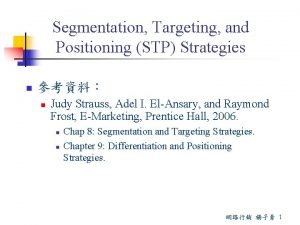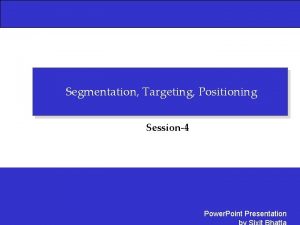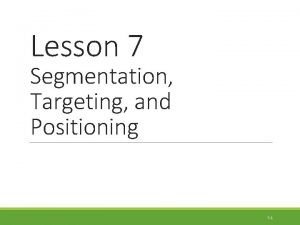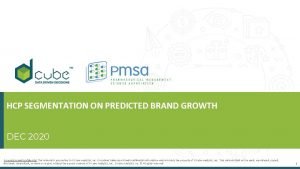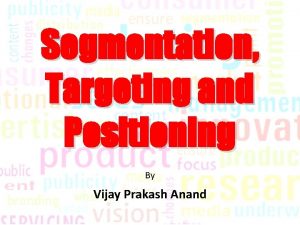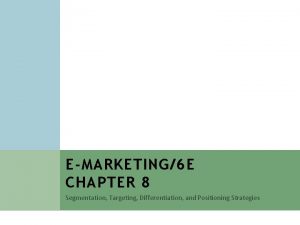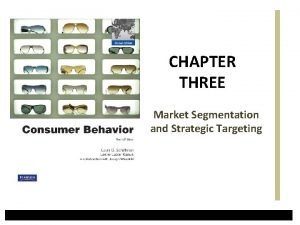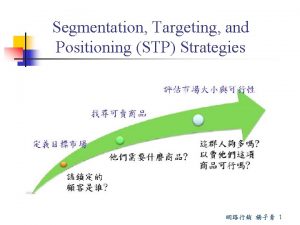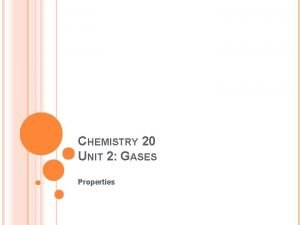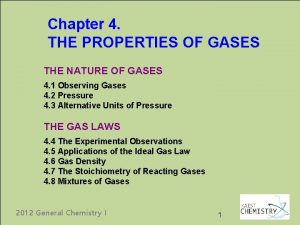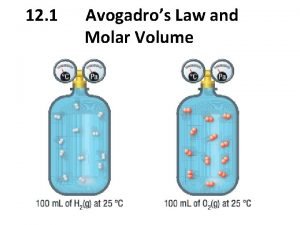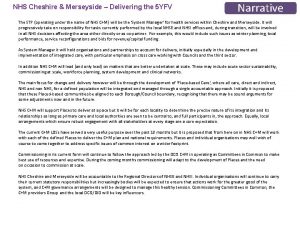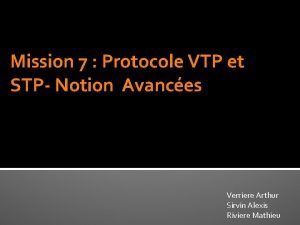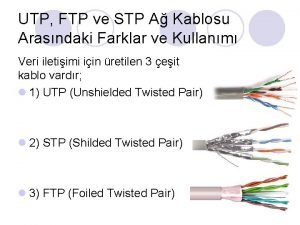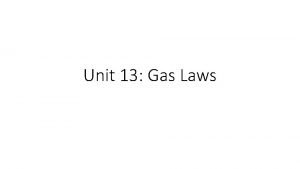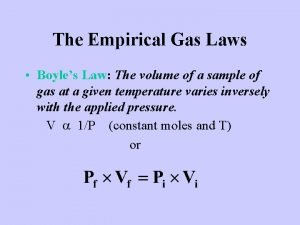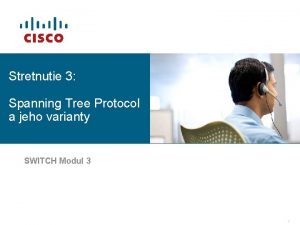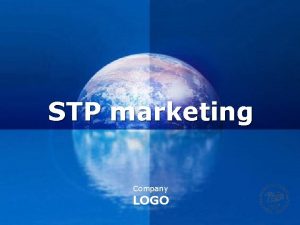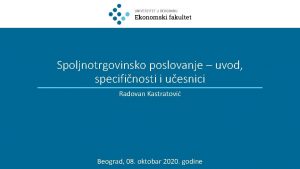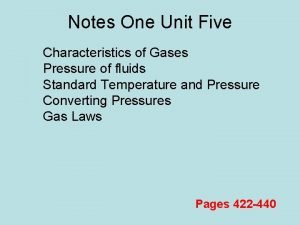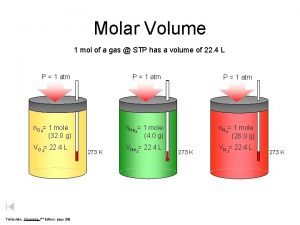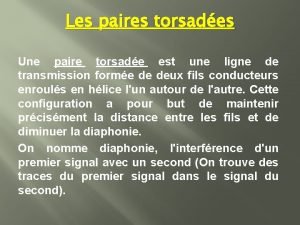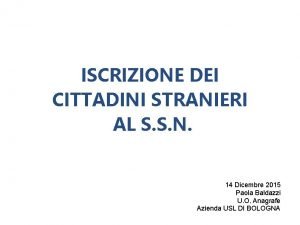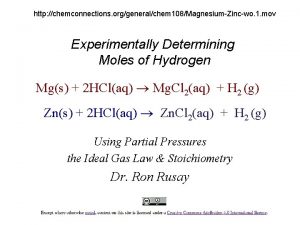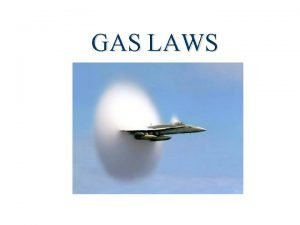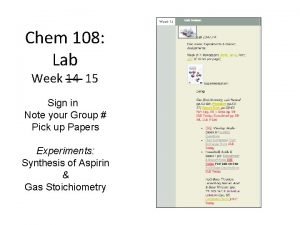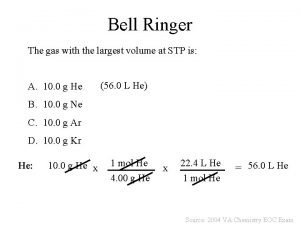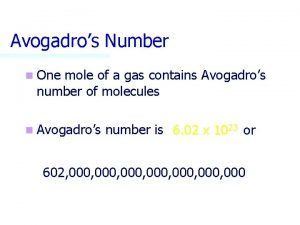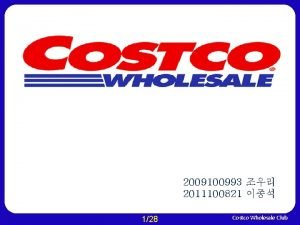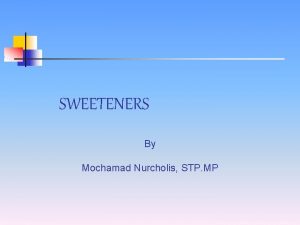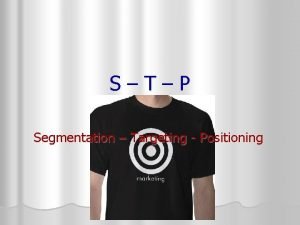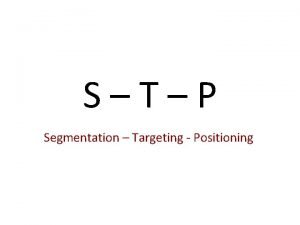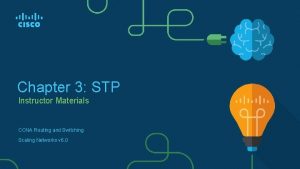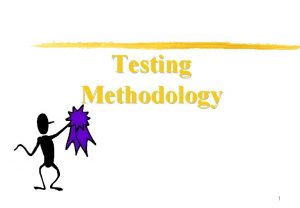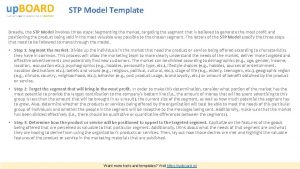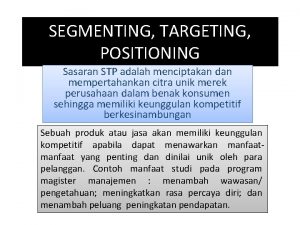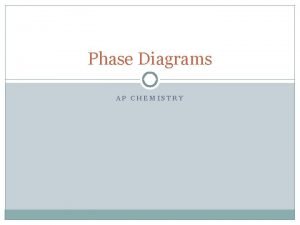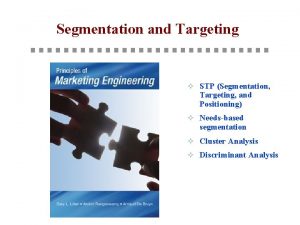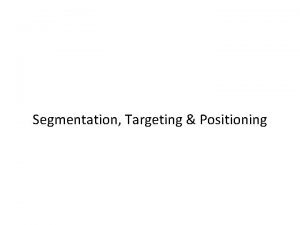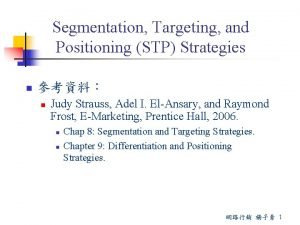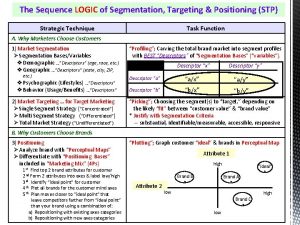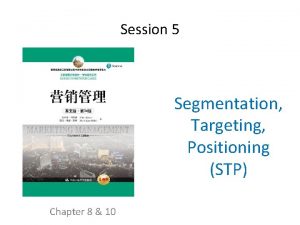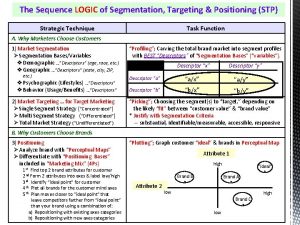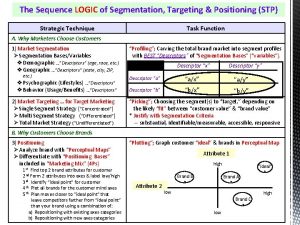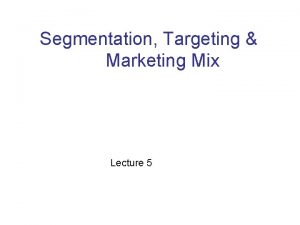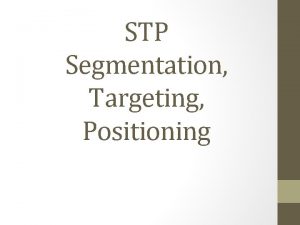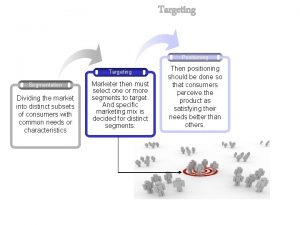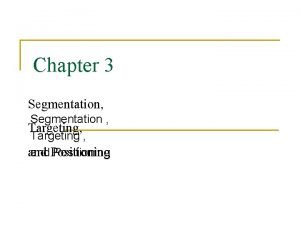Segmentation and Targeting q Concepts STP q Methods







































































- Slides: 71

Segmentation and Targeting q Concepts: STP q Methods q Case Intros

How STP Creates Value Segmentation Identify segments Targeting Select segments Positioning Create competitive advantage Marketing resources are focused to better meet customers needs and deliver more value to them Customers develop preference for brands that better meet their needs and deliver more value Customers become brand/supplier loyal, repeat purchase, communicate favorable experiences Brand/supplier loyalty leads to increased market share and creates a barrier to competition Fewer marketing resources needed over time to maintain share due to brand or supplier loyalty Profitability (value to the firm) increases 2

Find Value-Based Segments “The Market” Vs. “Segments” Competency in Segment q Evaluate competencies vs. attractiveness High A D F B Average E G Low I Low C J Average High Segment Attractiveness 3

Market Segmentation q Market segmentation is the subdividing of a market into distinct subsets of customers. Segments q Members are different between segments but similar within. 4

Markets are Dynamic § § Segments may be unstable over time § Buyer behavior changes § Competitors change § The business environment changes This means that it is important to view segmentation as. . . § A process to support business decisions § Not a static classification of the market 5

The Many Uses of Segmentation Short-term segmentation applications: § Salesforce allocation/call planning § Channel assignment § Communication program development: § spending, allocation and messaging Pricing Focus on today’s competitors and my current relative advantage to the customer 6

The Many Uses of Segmentation Longer term: term § § Emerging needs (Opportunity-focused segmentation) New and evolving segments to serve Planning for segment development/growth and anticipating competitive threats Key-influencer spill-over Market driving (vs. customer focused) 7

Currently, Most Segmentation Projects Provide…. Insights… 8

SAMPLE SEGMENTATION STUDY FOR A HEADACHE REMEDY Chronic Combatants % Adults: Reluctantly Reliants Super-Stressed Reactionaries Savvy Functionalists 10% 14% 12% Past 30 Day Headache: Sufferers 100%= Volume 100%= Med Treaters 100%= Med Volume 100%= 13% 25% 13% 16% 13% 20% 16% 18% 16% 15% % Suffer Reg/Occ’ly Regularly 82% 35% 58% 20% 75% 23% 63% 10% 4. 4 3. 7 4. 0 3. 3 Severity of Headache (6 pt scale) 17% 19% 16% 21% 17% Disciplined Bodies 17% 13% 8% 13% 10% 45% 8% 3. 1 % of All Headaches: % Mild / Moderate 100%= % Severe 100%= % Migraine 100%= 16% 31% 33% 12% 9% 12% 18% 20% 18% 12% 9% 11% 13% 10% 13% Share of Pain Days: % Mild / Moderate % Severe % Migraine 100% 45% 33% 22% 100% 65% 20% 15% 100% 60% 25% 100% 68% 14% 100% 65% 20% 15% Reaction to Headache Sharply Limits Life Concern Upsetting, Distracts From Responsibilities Reach for the Cure (Med) Quickly Treat Judiciously Treatment Mostly Rx, OTC … With Non-meds Rx and OTC. . . Relaxation Put off Till Severe, Then OTC Meds at First Twinge Move About; OTC Meds If Gets Worse Desired Med Aspects Powerful, Long-lasting Relief Safe Immediacy Fast No Side Effects Targeting Opportunities 9

In the Final Analysis…. Little Measurable Value …… Most segmentation projects are one-time Projects that drain resources 10

A Four-Phase Process for Successful Segmentation Analysis Project Phase I Planning and Design Internal Assessment & Planning Objective(s) of segmentation Resources Constraints Database Review Primary data already available Secondary data … Prototype Implementation Exercises What ifs? Phase II Qualitative Assessment Qualitative Research Interview Materials Development · · Qualitative Data Collection · · “Deep needs” Identification · · Decision-Making Process Assessment · · Phase IV Analysis and Implementation Phase III Quantitative Measurement Quantitative Survey Sample Design · · · Segmentation Analysis Cluster Analysis Portfolio Analysis Questionnaire Development · · · Data Collection · · · Positioning Analysis Implementation Through Database Tools Call Center Web Classification Tool Development Discriminant function Sales call patterns Promotion …. Binary (CART) tree … Relevant groups involved? …. . 11

Primary Characteristics of Segments q Bases—characteristics that tell us why segments differ (e. g. , needs, preferences, decision processes). q Descriptors—characteristics that help us find and reach segments. (Business markets) (Consumer markets) Industry Age/Income Size Education Location Profession Organizational Life styles structure Media habits 12

Variables to Segment and Describe Markets Consumer Industrial Segmentation Bases Needs, wants benefits, solutions to problems, usage situation, usage rate, size*, industrial*(*=macro-bases) Descriptors Demographics Age, income, marital status, family type & size, gender, social class, etc. Lifestyle, values, & personality characteristics. Use occasions, usage level, complementary & substitute products used, brand loyalty, etc. Individual or group (family) choice, low or high involvement purchase, attitudes and knowledge about product class, price sensitivity, etc. Level of use, types of media used, times of use, etc. Industry, size, location, current supplier(s), technology utilization, etc. Personality characteristics of decision makers. Use occasions, usage level, complementary & substitute products used, brand loyalty, order size, applications, etc. Formalization of purchasing procedures, size & characteristics of decision making group, use of outside consultants, purchasing criteria, (de)centralizing buying, price sensitivity, switching costs, etc. Level of use, types of media used, time of use, patronage at trade shows, receptivity of sales people, etc. Psychographics Behavior Decision Making Media Patterns 13

Managing Segmentation 1. Define segmentation problem 2. Conduct market research 3. Build segmentation database 4. Define market segments 5. Describe market segments 6. Implement results! 14

1. Define Segmentation Problem q View market segmentation problem as a series of hierarchical stages -- for example § Identify broad strategic “macro-segments” that effectively define market structure q Industry groups q Product usage (rate of usage, application, etc. ) q Geographic location, etc. § Within macro-segments, conduct research to find “micro -segments” for competitive advantage q Segmentation on buyer needs and value q Segmentation on product benefits 15

Levels of Segmentation Mass Market Macro Segments A B C Micro Segments of One 16

2. Conduct Market Research Phase 1 Phase 2 Phase 3 Exploratory Study Market Segmentation Study Segment Response Analysis & Planning Implement Marketing Program Market research supports the segmentation process 17

3. Build Segmentation Database Importance Competitor Usage Response Importance ratings perceptions variables Demog Factors Org # BC # Resp # 1 …………k 1…………. . r 1………. s 1…………t 1……. v 1………. m<k 1 1 1 1 2 2 2 etc. 1 1 1 2 2 1 1 2 3 4 1 2 3 8 9 3 4 2 5 9 8 9 6 9 8 8 6 etc. 9. . . 8 2 9 3 etc. 18

4. Define Market Segments q Assume the following data matrix includes the responses from six customers on four key components of value (10 point rating scale of importance) q How would you segment this “market”? 19

5. Describe Market Segments q Suppose the market for 300 users of industrial adhesives were represented by the table below Organization size as a descriptor Segments based on needs q What can we conclude from this table? 20

Industrial Adhesive Buyers 21

Respondent Selection/Aggregation Issues q Who makes the purchasing decision: ? DMU (decision making unit)? q Roles of individuals § § § Purchasing agent? User? Specifier? Gatekeeper? Financial analyst? q How many respondents per unit? q If more than one, how to aggregate? 22

Segmentation: Methods Overview q Factor analysis (to reduce data before cluster analysis). q Cluster analysis to form segments. q Discriminant analysis to describe segments. 23

Cluster Analysis for Segmenting Markets q Define a measure to assess the similarity of customers on the basis of their needs. q Group customers with similar needs. The software uses the “Ward’s minimum variance criterion” and, as an option, the K-Means algorithm for doing this. q Select the number of segments using numeric and strategic criteria, and your judgment. q Profile the needs of the selected segments (e. g. , using cluster means). 24

Cluster Analysis Issues q Defining a measure of similarity (or distance) between segments. q Identifying “outliers. ” q Selecting a clustering procedure § Hierarchical clustering (e. g. , Single linkage, average linkage, and minimum variance methods) § Partitioning methods (e. g. , K-Means) q Cluster profiling § Univariate analysis § Multiple discriminant analysis 25

Doing Cluster Analysis a = distance from member to cluster center b = distance from I to III • Dimension 2 • • Perceptions or ratings data from one respondent III b I • • a • • • II Dimension 1 26

Single Linkage Cluster Example Distance Matrix Co#1 Company #2 Company #3 Company #4 Company #5 0. 00 Co#2 Co#3 Co#4 Co#5 0. 00 1. 49 3. 42 1. 81 5. 05 0. 00 2. 29 1. 99 4. 82 0. 00 1. 48 4. 94 0. 00 4. 83 Resulting Dendogram 1 2 Company 3 4 5 1 2 3 Distance 4 5 27

Ward’s Minimum Variance Agglomerative Clustering Procedure First Stage: 10 A = E = 2 15 B = 5 C = 9 AB = 4. 5 BD = 12. 5 AC = 24. 5 BE = 50. 0 AD = 32. 0 CD = 0. 5 AE = 84. 5 CE = 18. 0 BC = 8. 0 DE = 12. 5 CDA = 38. 0 CDB = 14. 0 CDE = 20. 66 AB = 85. 0 BE = 50. 5 ABCD = 41. 0 ABE= 93. 17 CDE = Second Stage: Third Stage: 5. 0 AE = Fourth Stage: 25. 18 Fifth Stage: ABCDE = 98. 8 D = 28

Ward’s Minimum Variance Agglomerative Clustering Procedure 98. 80 25. 18 5. 00 0. 50 A B C D E 29

Interpreting Cluster Analysis Results q Select the appropriate number of clusters: § Are the bases variables highly correlated? (Should we reduce the data through factor analysis before clustering? ) § Are the clusters separated well from each other? § Should we combine or separate the clusters? § Can you come up with descriptive names for each cluster (eg, professionals, techno-savvy, etc. )? q Segment the market independently of your ability to reach the segments (i. e. , separately evaluate segmentation and discriminant analysis results). 30

Profiling Clusters Two Cluster Solution for PC Data: Need-Based Variables 1 Design Means of Variables 0 Business – 1 size power office use LAN color storage wide periph. budget needs connect. 31

Discriminant Analysis for Describing Market Segments q Identify a set of “observable” variables that helps you to understand how to reach and serve the needs of selected clusters. q Use discriminant analysis to identify underlying dimensions (axes) that maximally differentiate between the selected clusters. 32

Two-Group Discriminant Analysis Price Sensitivity X-segment x = high propensity to buy o = low propensity to buy XXOXOOO XXXOXXOOOO XXXXOOO XXOXXOXOOOOOOO Need for Data Storage O-segment 33

Interpreting Discriminant Analysis Results q What proportion of the total variance in the descriptor data is explained by the statistically significant discriminant axes? q Does the model have good predictability (“hit rate”) in each cluster? q Can you identify good descriptors to find differences between clusters? (Examine correlations between discriminant axes and each descriptor variable). 34

Implementing Segmentation Tree-Based Classification Tool Q 1_1: How would you rate your current overall health? Q 1_16 J: My doctor is very competent and good at what s/he does. Q 3_13 AA: Prescription medication reduces risk of heart attacks and stroke. Q 4_15: Have you ever asked your doctor about a specific brand medication for your high cholesterol? Q 1_16 J: My doctor is very competent and good at what s/he does. Q 3_13 CJ: Exercise makes me feel better/healthier. Q 3_13 AA: Prescription medication reduces risk of heart attacks and stroke. 35

Integrating Targeting and Relationship Management “Best Offer” Query Model: Female-owned small business Other ____ Alternative Model N Customer Access Problem? Y Y Call/Caller Priorities? Customized Recommendation Work at Home? Terminate Y Caller ID? N N Offer A N N Which Complaints? • Can’t Find You • Busy Signal • Frustrating Voice-Mail • Put on Hold Too Long • Other Professional/Social/Personal Services Line of Business? Offer D N Offer C Have Website? N Terminate Y Customer Access Problem? Y Compete with personalized service? Y Offer B Y Offer D 36

Managerial Uses of Segmentation Analysis q Select attractive segments for focused effort (Can use models such as Analytic Hierarchy Process or GE Planning Matrix, or Response Model). q Develop a marketing plan (4 P’s and positioning) to target selected segments. § In consumer markets, we typically rely on advertising and channel members to selectively reach targeted segments. § In business markets, we use sales force and direct marketing. You can use the results from the discriminant analysis to assign new customers to one of the segments. 37

Checklist for Segmentation 1. Is it values, needs, or choice-based? Whose values and needs? 2. Is it a projectable sample? 3. Is the study valid? (Does it use multiple methods and multiple measures) 4. Are the segments stable? 5. Does the study answer important marketing questions (product design, positioning, channel selection, sales force strategy, sales forecasting) 6. Are segmentation results linked to databases? 7. Is this a one-time study or is it a part of a long-term program? 38

Segmentation Summary In summary, q Use needs variables to segment markets. q Select segments taking into account both the attractiveness of segments and the strengths of the firm. q Use descriptor variables to develop a marketing plan to reach and serve chosen segments. q Develop mechanisms to implement the segmentation strategy on a routine basis (one way is through information technology). 39

Targeting Price Sensitivity/ Pain of Expenditure (Importance) . . . Segment(s) to serve Need for Premium Service/Differentiation (Importance) 40

Which Segments to Serve? —Segment Attractiveness Criteria Criterion I. Size and Growth 1. Size 2. Growth Examples of Considerations • Market potential, current market penetration • Past growth forecasts of technology change II. Structural Characteristics 3. Competition 4. Segment saturation 5. Protectability 6. Environmental risk III. Product-Market Fit 7. Fit 8. Relationships with segments 9. Profitability • Barriers to entry, barriers to exit, position of competitors, ability to retaliate • Gaps in the market • Patentability of products, barriers to entry • Economic, political, and technological change • Coherence with company’s strengths and image • Synergy, cost interactions, image transfers, cannibalization • Entry costs, margin levels, return on investment 41

Selecting Segments to Serve E Strong Firm’s Competitive Position B Medium D Weak A C Low Average High Segment Attractiveness 42

Mc. Kinsey/GE Approach 1. Specify drivers of each dimension 2. Weight drivers 3. Rate SBUs on each driver 4. Multiply weights times rates for each SBU 5. View resulting graph 6. Review/sensitivity analysis 43

Choice Models for Individual Customer Targeting 1. Observe choice Buy/not buy Brand bought Share of req’ts direct marketers packaged goods, ABB materials Mfg’rs 2. Capture related data • • • demographics attitudes/perceptions market conditions (price, promotion, etc. ) 3. Link 1 to 2 via “choice model” model reveals importance weights of characteristics 44

Contexts in Which Choice Models are Appropriate q Binary Choice q Multinomial Choice § Buy or Not Buy § Tide, Cheer, Yes, or Wisk § Yes or No § Bus, Train, or Plane § Own or Don’t own § Yes, No, Don’t Know § Bush or Kerry Choices are mutually exclusive. The customer chooses only one of the options at a given choice occasion. 45

Using Choice Models • Choice Model Inputs • Past purchases/shares of reqt’s • Market conditions (prices, etc. ) • Customer attitudes (surveys) • Etc. • Choice Model Outputs • Purchase probability or share of requirements BY CUSTOMER 46

Choice Models vs Surveys With standard survey methods. . . preference/ choice ï ñ predict importance weights ´ perceptions ñ ñ observe/ask Choice models give us… choice ï ñ observe importance weights ´ ñ infer perceptions ñ observe/ask 47

Why Choice Models in Marketing? q Ever more data available about choices customers/prospects make. Much of this data is automatically collected (e. g. , scanners, web logs). q Such data are useful for: § Predictive modeling: Usually, an individual’s past behavior (choices) is a better predictor of his/her future actions than stated attitudes or intentions. § Generating diagnostics: Identifying the important drivers of customer choices. § Segmenting customers: Grouping customers on the basis of similarities in their choice drivers/process. 48

Using Choice Models for Customer Targeting Step 1 Create database of customer responses (choices) based either on test mailing to a sample of prospects/customers, or historical data of past customer purchases. Step 2 Use models such as regression, RFM, and Logit to assess the impact of independent variables (drivers) of customer response. Step 3 Score each customer/prospect based on the drivers identified in Step 2 - the higher the score, the more likely is the predicted response. Step 4 Classify customers into deciles (or smaller groupings) based on their scores. Step 5 Based on profitability analyses, determine the top deciles to which a marketing action (e. g. , mailing of brochure) will be targeted. 49

Database for Book. Binders Book Club Case Step 1 Predict response to a mailing for the book, Art History of Florence, based on the following variables accumulated in the database and the responses to a test mailing: § § § § § Gender Amount purchased Months since first purchase Months since last purchase Frequency of purchase Past purchases of art books Past purchases of children’s books Past purchases of cook books Past purchases of DIY books Past purchases of youth books 50

Step 2 Drivers of the RFM Model Time/purchase occasions since the last purchase R Recency F Frequency Number of purchase occasions since first purchase M Monetary Value Amount spent since the first purchase 51

Step 2 Computing Scores Using RFM Model Assign score to R, F, and M based on past experience. Recency Last purchased in the past 3 months 25 points Last purchased in the past 3 - 6 months 20 Last purchased in the past 6 - 9 months 10 Last purchased in the past 12 - 18 months 5 Last purchased in the past 18 months 0 Come up with similar “scoring rules” for Frequency and Monetary (Implement as Nested If Statements in Excel). RFM score for a customer = R score + F score + M score 52

Step 2 Computing Scores Based on Regression model to predict probability of purchase: Pij = wo + wkbijk + ij . . . (1) where Pij is the probability that individual i will choose alternative j, wk is the regression coefficient for the kth variable (e. g. , Gender) and bijk are values of the kth variable for the ith individual and jth choice alternative. Note that Pij computed in this manner need not necessarily lie between 0 and 1. 53

Step 2 The Logit Model The objective of the model is to predict the probabilities that the individual will choose each of several choice alternatives The model has the following properties: § The probabilities lie between 0 and 1, and sum to 1. § The model is consistent with the proposition that customers pick the choice alternative that offers them the highest utility on a purchase occasion, but the utility has a random component that varies from one purchase occasion to the next. § The model has the proportional draw property -- each choice alternative draws from other choice alternatives in proportion to their utility. 54

Step 2 Logit Model of Response to Direct Mail Probability of behavior, responding to = effort, direct mail characteristics of solicitation function of (past response marketing customers) 55

Step 2 Technical Specification of the Multinomial Logit Model Individual i’s probability of choosing brand 1 or choice alternative 1 (Pi 1) is given by: . . . (2) where Aij is the “attractiveness” of alternative j to customer i = å wk bijk is the value (observed or measured) of variable k (e. g. , Gender) for alternative j when customer i made a purchase. wk is the importance weight associated with variable k (estimated by the model). Similar equations can be specified for the probabilities that customer i will choose other alternatives. 56

Step 2 Technical Specification of the Multinomial Logit Model On each purchase occasion, the (unobserved) utility that customer i gets from alternative j is given by: …(3) where ij is an error term. Notice that utility is the sum of an observable term (Aij) and an unobservable term ( ij). 57

Step 2 Example: Choosing Among Three Brands bijk Brand Performance Quality Variety Value A 0. 7 0. 5 0. 7 B 0. 3 0. 4 0. 2 0. C 0. 6 0. 8 0. 7 0. 4 D (new) 0. 6 0. 4 0. 8 0. 5 Estimated Importance Weight (wk) 2. 0 1. 7 1. 3 2. 2 58

Step 2 Example Computations (a) Brand Aij = wk bijk (b) (c) (d) (e) Share estimate. Draw without with (c)–(d) new brand A 4. 70 109. 9 0. 512 0. 407 0. 105 B 3. 30 27. 1 0. 126 0. 100 0. 026 C 4. 35 77. 5 0. 362 0. 287 0. 075 D 4. 02 55. 7 0. 206 59

Step 2 An Important Implication of the Logit Model. . . (4) High Marginal Impact of a Marketing Action ( ) Low 0. 0 0. 5 1. 0 Probability of Choosing Alternative 1 ( ) 60

Step 2 Segmentation in Choice Models Using Latent Class Analysis q Basic Idea: The population of customers consists of several segments, and the values of the variables of interest (e. g. , Gender, Amount purchase) are imperfect indicators of the segment to which a customer belongs. q Operationally, this means that the weights (w’s) of the choice model in (2) differ across segments, but the segments are unknown (latent) and have to inferred from the data. . (5) 61

Step 2 Segmentation in Choice Models Using Latent Class Analysis q The latent class segmentation model is implemented in the Marketing Engineering software using the EM (Expectation Maximization) algorithm. q As in the traditional cluster analysis model, specify a different number of segments, and see which specification makes the most sense. Use the AIC of BIC criterion to help statistically determine the number of segments in the data set. q For the Book. Binders case, only the one-segment solution makes sense. 62

Step 3 Compute Choice Scores (Probability of Purchase) q RFM Model: Use computed score as an index of the probability of purchase. q Regression: q Logit: 's are weights estimated by the Regression or Logit models. RFM and Regression models can be implemented in Excel. Also, all three scoring procedures for “probability of purchase” can be implemented in Excel. 63

Step 3 Score Customers for their Potential Profitability (Example) A D Score B C Average Customer (Purchase $ Customer Probability) C Expected Volume Margin 1 30% $31. 00 0. 70 2 0. 60 6. 51 2% 1. 72 $143. 00 3 10% $54. 00 0. 67 4 0. 62 5 0. 58 3. 62 5% 2. 73 60% 6. 96 =A´B´ $88. 00 $20. 00 64

Step 4 Decile Classification q Standard Assessment Method § Apply the results of approach and calculate the “score” of each individual (calibration vs test sample) § Divide into deciles § Calculate/graph hit rate and profit Score 1. 00 Score 0. 99 Score 0. 92 …. . Order the customers based on “score” from the highest to the lowest …. . § Customer 1 Customer 2 Decile 1 …. Customer 230 Decile 10 Customer 2300 Score 0. 00 65

Step 4 Decile Classification Example Decile Customer(s) 1 6. 96 2 6. 51 3 6. 20 4 3. 62 $ 5 1 6 3 5 3. 35 6 3. 22 8 7 2. 73 4 9 1. 72 2 7 If the marketing cost to reach a 8 customer is 10 $3, at what decile will you will stop your targeting effort? How is this targeting plan different from one based on 1. 87 average purchases of customers ($3. 72)? 66

Step 5 Determine Targeting Plan (Example shows potential profitability of mailing to the top 6 deciles) Compute profit/ROI for the models based on the number of mailings recommended by each model and compare that to mailing to the entire list (equivalently to a randomly selected list of the same size). 67

Step 5 Choosing the Model and Rule 68

Attributes in ABB’s Choice-Segmentation Model q Invoice price q Energy losses q Overall product quality q Availability of spare parts q Clarity of bid document q Knowledgeable salespeople q Maintenance requirement q Ease of installation q Warranty 69

Applying Choice Models in Customer Targeting at ABB Key idea: Segment on the basis of probability of choice— 1. Loyal to us 2. Loyal to competitor—BZ customers 3. Switchables: loseable/winnable customers 70

Switchability Segmentation Loyal to Us Losable Winnable Customers Loyal to Competitor (business to gain) Current Product-Market by Switchability (ABB Procedure) Questions: Where should your marketing efforts be focused? How can you segment the market this way? 71
 Undifferentiated products examples
Undifferentiated products examples Segmentation vs targeting
Segmentation vs targeting Nivea segmentation, targeting and positioning
Nivea segmentation, targeting and positioning Positioning segmentation
Positioning segmentation Sony market segmentation, targeting and positioning
Sony market segmentation, targeting and positioning Segmentation targeting differentiation and positioning
Segmentation targeting differentiation and positioning Chosen lesson 7 segment 1
Chosen lesson 7 segment 1 Advanced hcp targeting
Advanced hcp targeting Nokia target market
Nokia target market For upscale american families volvo
For upscale american families volvo Global consumer culture positioning example
Global consumer culture positioning example Psychographic segmentation
Psychographic segmentation Marketing segmentation targeting positioning
Marketing segmentation targeting positioning Market segmentation in principles of marketing
Market segmentation in principles of marketing Market segmentation, targeting and positioning
Market segmentation, targeting and positioning Stp in rural marketing
Stp in rural marketing Stp of colgate
Stp of colgate Benefits sought segmentation
Benefits sought segmentation Segmentation targeting differentiation and positioning
Segmentation targeting differentiation and positioning Market segmentation targeting and positioning of coca cola
Market segmentation targeting and positioning of coca cola Global segmentation targeting and positioning
Global segmentation targeting and positioning Global segmentation and positioning
Global segmentation and positioning Market segmentation and strategic targeting
Market segmentation and strategic targeting Bssu
Bssu Stp concepts
Stp concepts Direct and indirect wax pattern
Direct and indirect wax pattern Live healthy be happy
Live healthy be happy Stp and satp
Stp and satp Stp and satp
Stp and satp Avogadro's law and molar volume at stp
Avogadro's law and molar volume at stp Cheshire and merseyside stp
Cheshire and merseyside stp Vtp and stp
Vtp and stp Lesson 64 stp the mole and avogadro law answer key
Lesson 64 stp the mole and avogadro law answer key Herts and west essex stp
Herts and west essex stp Utp ve stp kablo arasındaki fark
Utp ve stp kablo arasındaki fark Formula for boyle's law
Formula for boyle's law Uk competition ratio
Uk competition ratio Empirical gas laws
Empirical gas laws Spanning-tree bpdu-protection
Spanning-tree bpdu-protection Stp stratégia
Stp stratégia Stp ekof
Stp ekof Stp theory
Stp theory Stp conditions
Stp conditions Stp conditions
Stp conditions Satp volume
Satp volume Stp stratégia
Stp stratégia Pair torsadé
Pair torsadé Stp theory
Stp theory Codice stp
Codice stp Stp vs standard conditions
Stp vs standard conditions Stp for gases
Stp for gases Gas law
Gas law Stp conditions
Stp conditions Stp vs standard conditions
Stp vs standard conditions Stp chemistry
Stp chemistry Xxx bellringer
Xxx bellringer Kahoot it
Kahoot it Costco matrix
Costco matrix Proces stp
Proces stp Stp
Stp Social marketing segmentation
Social marketing segmentation Ada berapa banyak segmen prizm?
Ada berapa banyak segmen prizm? Stp plastics
Stp plastics Segmentation kotler
Segmentation kotler Stp
Stp Stp analysis marketing
Stp analysis marketing Stp software test plan
Stp software test plan Surveilans terpadu adalah
Surveilans terpadu adalah Stp model template
Stp model template Stp adalah
Stp adalah Utp abd stp are example of
Utp abd stp are example of Unlabeled phase diagram
Unlabeled phase diagram
